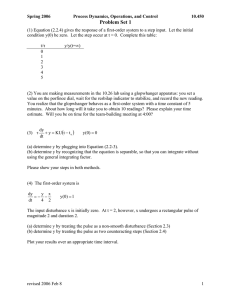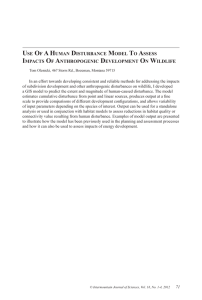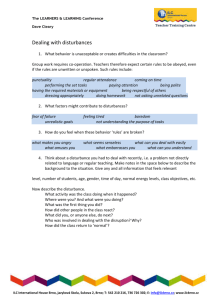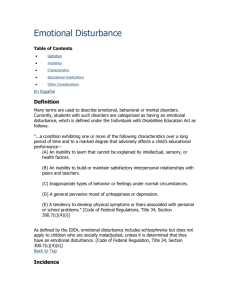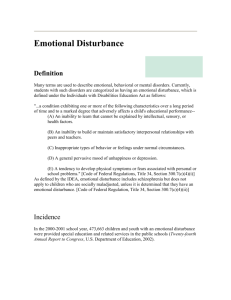Lesson 2: Mathematics Review
advertisement
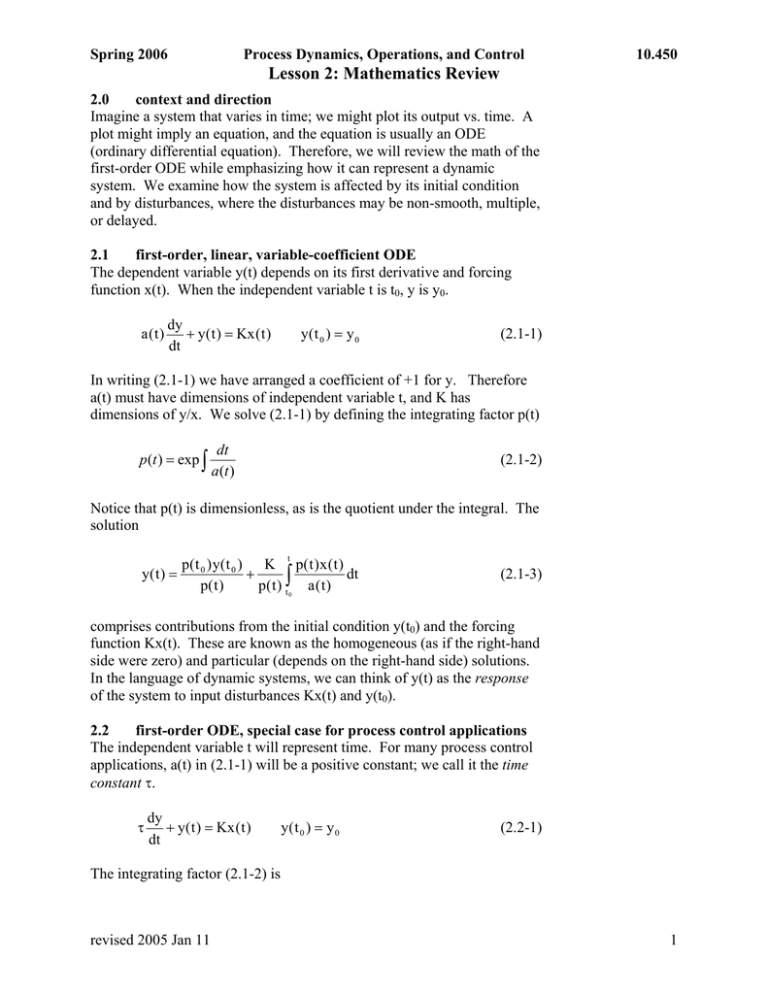
Spring 2006 Process Dynamics, Operations, and Control 10.450 Lesson 2: Mathematics Review 2.0 context and direction Imagine a system that varies in time; we might plot its output vs. time. A plot might imply an equation, and the equation is usually an ODE (ordinary differential equation). Therefore, we will review the math of the first-order ODE while emphasizing how it can represent a dynamic system. We examine how the system is affected by its initial condition and by disturbances, where the disturbances may be non-smooth, multiple, or delayed. 2.1 first-order, linear, variable-coefficient ODE The dependent variable y(t) depends on its first derivative and forcing function x(t). When the independent variable t is t0, y is y0. a (t) dy + y( t ) = Kx ( t ) dt y( t 0 ) = y 0 (2.1-1) In writing (2.1-1) we have arranged a coefficient of +1 for y. Therefore a(t) must have dimensions of independent variable t, and K has dimensions of y/x. We solve (2.1-1) by defining the integrating factor p(t) p(t ) = exp ∫ dt a(t ) (2.1-2) Notice that p(t) is dimensionless, as is the quotient under the integral. The solution t p( t 0 ) y( t 0 ) K p( t ) x ( t ) y( t ) = + dt p( t ) p( t ) t∫0 a ( t ) (2.1-3) comprises contributions from the initial condition y(t0) and the forcing function Kx(t). These are known as the homogeneous (as if the right-hand side were zero) and particular (depends on the right-hand side) solutions. In the language of dynamic systems, we can think of y(t) as the response of the system to input disturbances Kx(t) and y(t0). 2.2 first-order ODE, special case for process control applications The independent variable t will represent time. For many process control applications, a(t) in (2.1-1) will be a positive constant; we call it the time constant τ. τ dy + y( t ) = Kx ( t ) dt y( t 0 ) = y 0 (2.2-1) The integrating factor (2.1-2) is revised 2005 Jan 11 1 Spring 2006 Process Dynamics, Operations, and Control 10.450 Lesson 2: Mathematics Review p( t ) = exp ∫ t dt =e τ τ (2.2-2) and the solution (2.1-3) becomes y( t ) = y 0 e −( t − t 0 ) t τ + K −t τ t τ e ∫ e x ( t )dt τ t0 (2.2-3) The initial condition affects the system response from the beginning, but its effect decays to zero according to the magnitude of the time constant larger time constants represent slower decay. If not further disturbed by some x(t), the first order system reaches equilibrium at zero. However, most practical systems are disturbed. K is a property of the system, called the gain. By its magnitude and sign, the gain influences how strongly y responds to x. The form of the response depends on the nature of the disturbance. Example: suppose x is a unit step function at time t1. Before we proceed formally, let us think intuitively. From (2.2-3) we expect the response y to decay toward zero from IC y0. At time t1, the system will respond to being hit with a step disturbance. After a long time, there will be no memory of the initial condition, and the system will respond only to the disturbance input. Because this is constant after the step, we guess that the response will also become constant. Now the math: from (2.2-3) y( t ) = y 0 e = y 0e −( t − t 0 ) −( t − t 0 ) t K −t τ t τ e ∫ e U( t − t1 )dt τ t0 τ + τ − ( t − t1 ) ⎛ τ ⎞ + KU( t − t1 )⎜1 − e ⎟ ⎠ ⎝ (2.2-4) Figure 2.2-1 shows the solution. Notice that the particular solution makes no contribution before time t1. The initial condition decays, and with no disturbance would continue to zero. At t1, however, the system responds to the step disturbance, approaching constant value K as time becomes large. This immediate response, followed by asymptotic approach to the new steady state, is characteristic of first-order systems. Because the response does not track the step input faithfully, the response is said to lag behind the input; the first-order system is sometimes called a first-order lag. revised 2005 Jan 11 2 Spring 2006 Process Dynamics, Operations, and Control 10.450 disturbance Lesson 2: Mathematics Review 1 0.5 0 2.5 0 1 2 3 4 5 6 0t 0 1 2t 1 3 4 5 6 response 2y 0 1.5 1K 0.5 0 time Figure 2.2-1 first-order response to initial condition and step disturbance 2.3 piecewise integration of non-smooth disturbances The solution (2.2-3) is applied over succeeding time intervals, each featuring an initial condition (from the preceding interval) and disturbance input. t −(t − t 0 ) ⎧ K −t τ t τ τ + e ∫ e x ( t )dt ⎪ y( t 0 )e τ t0 ⎪ ⎪ t − ( t − t1 ) t K −t ⎪ τ + e τ ∫ e τ x ( t )dt y ( t ) = ⎨ y ( t 1 )e τ t1 ⎪ ⎪etc. ⎪ ⎪⎩ t 0 < t < t1 t1 < t < t 2 (2.3-1) Example: suppose revised 2005 Jan 11 3 Spring 2006 Process Dynamics, Operations, and Control 10.450 Lesson 2: Mathematics Review dy y ( 0) = 0 +y=x dt 0 < t <1 ⎧0 ⎪ x = ⎨2(t − 1) 1 < t < 2 ⎪0 2<t ⎩ (2.3-2) In this problem, variables t, x, and y should be presumed to have appropriate, if unstated, units; in these units, both gain and time constant are of magnitude 1. From (2.3-1), ⎧0 ⎪ y( t ) = ⎨2 t − 2 + e −(t −1) ⎪2e −1e −( t − 2 ) ⎩ ( ) 0 < t <1 1< t < 2 (2.3-3) 2<t With a zero initial condition and no disturbance, the system remains at equilibrium until the ramp disturbance begins at t = 1. Then the output immediately rises in response, lagging behind the linear ramp. At t = 2, the disturbance ceases, and the output decays back toward equilibrium. revised 2005 Jan 11 4 Spring 2006 Process Dynamics, Operations, and Control 10.450 Lesson 2: Mathematics Review 2.5 disturbance 2 1.5 1 0.5 0 0 1 2 3 4 5 6 0 1 2 3 4 5 6 0.8 0.7 response 0.6 0.5 0.4 0.3 0.2 0.1 0 time 2.4 multiple disturbances and superimposition Systems can have more than one input. Consider a first-order system with two disturbance functions. τ dy + y( t ) = K1x 1 ( t ) + K 2 x 2 ( t ) dt y( t 0 ) = y 0 (2.4-1) Applying (2.2-3) and distributing the integral across the disturbances, we find that the effects of the disturbances on y are additive. y( t ) = y 0 e −( t − t 0 ) t τ + t t K1 − t τ t τ K −t e ∫ e x1 ( t )dt + 2 e τ ∫ e τ x 2 ( t )dt (2.4-2) τ τ t0 t0 This additive behavior is a happy characteristic of linear systems. Thus another way to view problem (2.4-1) is to decompose it into component problems. That is, define y = y H + y1 + y 2 revised 2005 Jan 11 (2.4-3) 5 Spring 2006 Process Dynamics, Operations, and Control 10.450 Lesson 2: Mathematics Review and write (2.4-1) in three equations. We put the initial condition with no disturbances, and each disturbance with a zero initial condition. dy H + yH (t) = 0 dt dy τ 1 + y1 ( t ) = K1x1 ( t ) dt dy τ 2 + y 2 (t) = K 2 x 2 (t) dt τ yH (t 0 ) = y0 y1 ( t 0 ) = 0 (2.4-4) y2 (t 0 ) = 0 Equations and initial conditions (2.4-4) can be summed to recover the original problem specification (2.4-1). The solutions are y H (t ) = y 0e −(t −t 0 ) τ t y1 ( t ) = K1 − t τ t τ e ∫ e x1 ( t )dt τ t0 y 2 (t ) = K 2 −t τ t τ e ∫ e x 2 ( t )dt τ t0 (2.4-5) t and of course these solutions can be added to recover original solution (2.4-2). Thus we can view the problem of multiple disturbances as a system responding to the sum of the disturbances, or as the sum of responses from several identical systems, each responding to a single disturbance. Example: consider 3 1 dy 1 + y = U ( t − 1) − U ( t − 3) 4 4 dt 4 y ( 0) = 2 (2.4-6) We first place the equation in standard form, in which the coefficient of y is +1. dy + y = 3U ( t − 1) − 4 U ( t − 3) dt y ( 0) = 2 (2.4-7) Equation (2.4-7) shows us that the time constant is 1, and that the system responds to the first disturbance with a gain of 3, and to the second with a gain of -4. The solution is y = 2e − t + 3U( t − 1)(1 − e − ( t −1) ) − 4U( t − 3)(1 − e − ( t −3) ) revised 2005 Jan 11 (2.4-8) 6 Spring 2006 Process Dynamics, Operations, and Control 10.450 Lesson 2: Mathematics Review In Figure 2.4-1, the individual solution components are plotted as solid traces; their sum, which is the system response, is a dashed trace. Notice how the first-order lag responds to each new disturbance as it occurs. disturbances 1 0.5 0 0 2 4 6 8 0 2 4 6 8 4 3 2 response 1 0 -1 -2 -3 -4 -5 time Figure 2.4-1 first-order response to multiple disturbances Writing the step functions explicitly in solution (2.4-8) emphasizes that particular disturbances do not influence the solution until the time of their occurrence. For example, if they were omitted, some deceptively correct but inappropriate rearrangement would lead to errors. ( ) ( y = 2e − t + 3 1 − e − ( t −1) − 4 1 − e − ( t −3) = 2e − t + 3 − 3e −( t −1) − 4 + 4e −( t −3) ) (do not do this!) (2.4-9) = −1 + 2e − t − 3e −( t −1) + 4e −( t −3) This notation at least implies that two of the exponential functions have delayed onsets. However, further correct-but-inappropriate rearrangement makes things even worse. revised 2005 Jan 11 7 Spring 2006 Process Dynamics, Operations, and Control 10.450 Lesson 2: Mathematics Review y = −1 + 2e − t − 3e − ( t −1) + 4e − ( t −3) = −1 + 2e − t − 3e1e − t + 4e 3e − t ( ) = −1 + 2 − 3e + 4e e 1 3 (do not do this!) (2.4-10) −t The incorrect solutions are plotted with (2.4-8) in Figure 2.4-2. Equation (2.4-9) has become discontinuous - the response takes non-physical leaps at the onset of each new disturbance. Equation (2.4-10) has lost all dependence on the disturbances and decays from a non-physical initial condition. Even with the mistakes, both incorrect solutions lead to the correct long-term condition. 20 response 15 10 5 0 -5 0 2 4 6 8 time solution eq 2.4.9 eq 2.4.10 Figure 2.4-2 comparison of correct and incorrect solutions 2.5 delayed response to disturbances Consider a system that reacts to a disturbance, but only after some intervening time interval θ has passed. That is τ dy + y( t ) = Kx ( t − θ) dt y( t 0 ) = y 0 (2.5-1) Equation (2.5-1) shows the dependence of y, at any time t, on the value of x at earlier time t - θ. The solution is written directly from (2.2-3). y( t ) = y 0 e −( t − t 0 ) t τ + K −t τ t τ e ∫ e x ( t − θ)dt τ t0 (2.5-2) We must integrate the disturbance considering the time delay. Take as an example a disturbance x(t) occurring at time t1. The plot shows the revised 2005 Jan 11 8 Spring 2006 Process Dynamics, Operations, and Control 10.450 Lesson 2: Mathematics Review disturbance, as well as the disturbance as the system experiences it, which begins at time t1 + θ. We could express this disturbance-as-experienced as some new function x1(t), occurring at time t1 + θ. disturbance as experienced by system disturbance as it occurs x(t) t0 x(t - θ) = x1(t) t1 + θ t1 t x(ξ) t0 - θ t1 - θ t1 ξ Alternatively, we could define a new time variable ξ = t−θ (2.5-3) and write the input as x(ξ). The integral in (2.5-2) becomes, then, t t t t ∫ e x (t − θ)dt = ∫ e x1 (t )dt = τ t0 τ t0 ξ ∫e ξ+θ τ x (ξ)dξ (2.5-4) t 0 −θ Therefore, solution (2.5-2) becomes y( t ) = y 0 e −( t − t 0 ) ξ τ ξ K −t θ + e τ e τ ∫ e τ x (ξ)dξ τ t 0 −θ (2.5-5) Example: consider a step disturbance at time t = 2 that affects the system 3 time units later. dy + y = x ( t − 3) dt x ( t ) = U( t − 2) y(0) = 0 (2.5-6) Using (2.5-5) revised 2005 Jan 11 9 Spring 2006 Process Dynamics, Operations, and Control 10.450 Lesson 2: Mathematics Review ξ y = e − t e 3 ∫ e ξ U(ξ − 2)dξ 0 −3 ξ ⎡2 ξ ⎤ = e e ⎢ ∫ e U(ξ − 2)dξ + ∫ e ξ U(ξ − 2)dξ⎥ 2 ⎣⎢0−3 ⎦⎥ −t 3 = e − t e 3 ⎡ U (ξ − 2)e ξ ⎤ ⎢⎣ 2⎥ ⎦ − t 3 t −3 = U( t − 3 − 2)e e e − e 2 (2.5-7) ξ [ = U( t − 5)[1 − e [ = U( t − 5) e t −3− t +3 − e 2− t +3 − ( t −5 ) ] ] ] Figure 2.5-1 shows that a typical first-order lag step response occurs 3 time units after being disturbed at t = 2. disturbances 1 0.5 0 0 2 4 6 8 10 0 2 4 6 8 10 1 response 0.8 0.6 0.4 0.2 0 time Figure 2.5-1 step response of first order system with dead time The time delay in responding to a disturbance is often called dead time. Dead time is different from lag. Lag occurs because of the combination of y and its derivative on the left-hand side of the equation. Dead time revised 2005 Jan 11 10 Spring 2006 Process Dynamics, Operations, and Control 10.450 Lesson 2: Mathematics Review occurs because of a time delay in processing a disturbance on the righthand side. 2.6 conclusion Please become comfortable with handling ODEs. View them as systems; identify their inputs and outputs, their gains and time parameters. revised 2005 Jan 11 11


